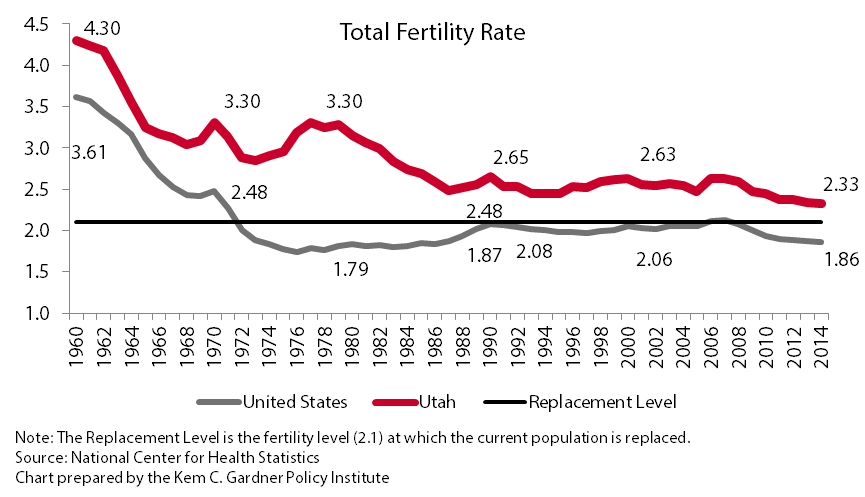Blog Post
Insight: Utah’s Fertility Rate is at Historic Low
By: Pamela S. Perlich, Ph.D.
Utah is well-known for its signature demographics, the most iconic of which is the highest total fertility rate in the nation. What is perhaps less well-recognized is that Utah’s fertility rate has fallen significantly since 1960, when it was 4.30 children per woman, to 2.33 in the most recent data for 2014. This is an historically low fertility rate for Utah, and only slightly exceeds the replacement level of 2.1. We can identify several key drivers of this change. Utah has become increasingly interconnected with the outside world, principally through markets, technology, and migrations of people. Nationally (and internationally), people have been delaying household formation, marriage, and childbearing as well as having fewer children. In addition, labor force participation rates and educational attainment of women have increased. As Utah has become more integrated into the national and global economy, households and individuals have been impacted by the same forces and factors that have influenced national trends. The most recent decline, observed from 2007 to 2014, is the imprint of the Great Recession. This was the most severe economic downturn since the Great Depression. Episodes of economic hardship have historically resulted in people delaying household formation and childbearing. This is because of ongoing financial hardship and insecurity. That has certainly been the case in the US and Utah, where the number of births has also declined over this period. This recessionary impact on childbearing is magnified for the young adults who have come of age during economic hard times. They are more risk averse (cautious) than young adults having come of age during economic good times and booms. It is still too early to evaluate how the recent change in policies of the LDS Church that have resulted in more young women serving missions has or will affect educational attainment, household formation, and fertility patterns. It is possible that some of these young women may have given birth to children in Utah had they not served missions and that this may have contributed to the most recent decline. What can we expect in the future? As the economy recovers it is reasonable to expect that some of the deferred births will finally occur as new young households are established and people regain confidence in their futures. But it seems clear that there will be a permanent imprint on the size and age structure of the population as fewer births will have occurred because of the Great Recession. But what about the trend declines in the total fertility rate or the impact of changes in the LDS Church missionary policy? These remain open questions for further research. Dr. Pamela S. Perlich is the director of demographic research at the Kem C. Gardner Policy Institute. Sources: Kem C. Gardner Policy Institute, January 2016, Utah Demographics Fact Sheet Brady E. Hamilton, et al., December 2015, Births: Final Data for 2014, National Center for Health Statistics, National Vital Records Report, Volume 64, Number 12. Andrew Cherlin, et al., November 2013, “The Effects of the Great Recession on Family Structure and Fertility,” The Annals of the American Academy, ASSPSS, 650. [1] These are total fertility rates which are calculated by summing the age-specific birth rates for all women of a given area for the referenced year. This captures the childbearing frequency of the female population for the reference year. It is not affected by age structure.






